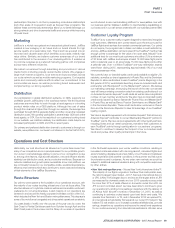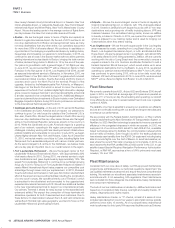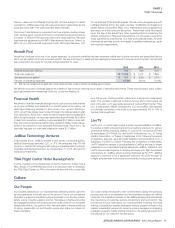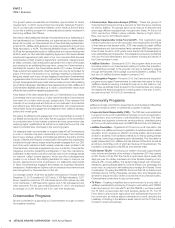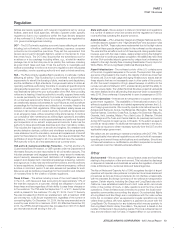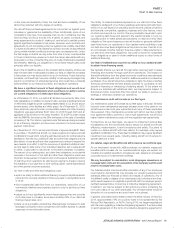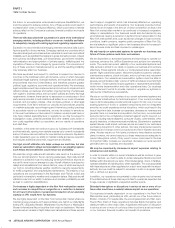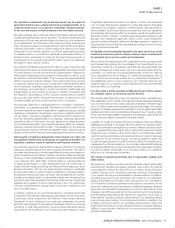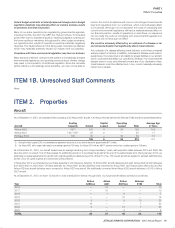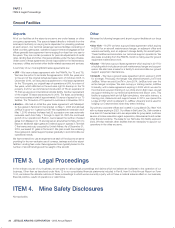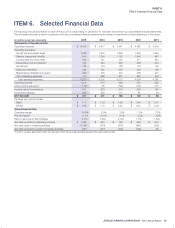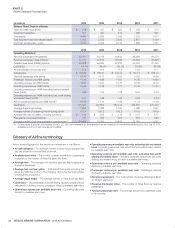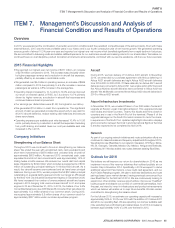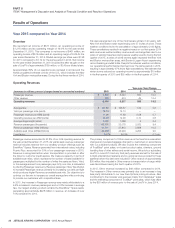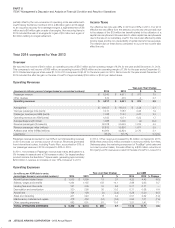JetBlue Airlines 2015 Annual Report Download - page 22
Download and view the complete annual report
Please find page 22 of the 2015 JetBlue Airlines annual report below. You can navigate through the pages in the report by either clicking on the pages listed below, or by using the keyword search tool below to find specific information within the annual report.
JETBLUE AIRWAYS CORPORATION-2015Annual Report18
PART I
ITEM1ARisk Factors
We are subject to the risks of having a limited number of suppliers for
our aircraft, engines and our Fly-Fi™ product.
Our current dependence on three types of aircraft and engines for all of
our flights makes us vulnerable to significant problems associated with the
International Aero Engines, or IAE V2533-A5 engine on our Airbus A321 fleet,
the International Aero Engines, or IAE V2527-A5 engine on our Airbus A320
fleet and the General Electric Engines CF34-10 engine on our Embraer E190
fleet. This could include design defects, mechanical problems, contractual
performance by the manufacturers, or adverse perception by the public which
would result in customer avoidance or in actions by the FAA resulting in an
inability to operate our aircraft. Carriers operating a more diversified fleet are
better positioned than we are to manage such events.
Our Fly-Fi™ service uses technology and satellite access through our
agreement with LiveTV, LLC. An integral component of the Fly-Fi™ system
is the antenna, which is supplied to us by LiveTV. If LiveTV were to stop
supplying us with its antennas for any reason, we would have to incur
significant costs to procure an alternate supplier. Additionally, if the satellites
Fly-Fi™ uses were to become inoperable for any reason, we would have
to incur significant costs to replace the service.
Our reputation and financial results could be harmed in the event of an
accident or incident involving our aircraft.
An accident or incident involving one of our aircraft could involve significant
potential claims of injured passengers or others in addition to repair or
replacement of a damaged aircraft and its consequential temporary or
permanent loss from service. We are required by the DOT to carry liability
insurance. Although we believe we currently maintain liability insurance in
amounts and of the type generally consistent with industry practice, the
amount of such coverage may not be adequate and we may be forced to
bear substantial losses from an accident. Substantial claims resulting from
an accident in excess of our related insurance coverage would harm our
business and financial results. Moreover, any aircraft accident or incident,
even if fully insured, could cause a public perception we are less safe or
reliable than other airlines which would harm our business.
An ownership change could limit our ability to use our net operating loss
carryforwards for U.S. income tax purposes.
As of December 31, 2015, we had approximately $65 million of federal net
operating loss carryforwards for U.S. income tax purposes that begin to
expire in 2033. Section 382 of the Internal Revenue Code imposes limitations
on a corporation’s ability to use its net operating loss carryforwards if it
experiences an “ownership change.” Similar rules and limitations may
apply for state income tax purposes. In the event an “ownership change”
were to occur in the future, our ability to utilize our net operating losses
could be limited.
Our business depends on our strong reputation and the value of the
JetBlue brand.
The JetBlue brand name symbolizes high-quality friendly customer
service, innovation, fun, and a pleasant travel experience. JetBlue is a
widely recognized and respected global brand; the JetBlue brand is one
of our most important and valuable assets. The JetBlue brand name and
our corporate reputation are powerful sales and marketing tools and we
devote significant resources to promoting and protecting them. Adverse
publicity, whether or not justified, relating to activities by our employees,
contractors or agents could tarnish our reputation and reduce the value of
our brand. Damage to our reputation and loss of brand equity could reduce
demand for our services and thus have an adverse effect on our financial
condition, liquidity and results of operations, as well as require additional
resources to rebuild our reputation and restore the value of our brand.
We may be subject to competitive risks due to the long term nature of
our fleet order book.
At present, we have existing aircraft commitments through 2023. As
technological evolution occurs in our industry, through the use of composites
and other innovations, we may be competitively disadvantaged because
we have existing extensive fleet commitments that would prohibit us from
adopting new technologies on an expedited basis.
Risks Associated with the Airline Industry
The airline industry is particularly sensitive to changes in economic
condition.
Fundamental and permanent changes in the domestic airline industry have
been ongoing over the past several years as a result of several years of
repeated losses, among other reasons. These losses resulted in airlines
renegotiating or attempting to renegotiate labor contracts, reconfiguring flight
schedules, furloughing or terminating employees, as well as considering
other efficiency and cost-cutting measures. Despite these actions, several
airlines have reorganized under Chapter 11 of the U.S. Bankruptcy Code
to permit them to reduce labor rates, restructure debt, terminate pension
plans and generally reduce their cost structure. Since 2005, the U.S. airline
industry has experienced significant consolidation and liquidations. The
global economic recession and related unfavorable general economic
conditions, such as higher unemployment rates, a constrained credit
market, housing-related pressures, and increased business operating costs
can reduce spending for both leisure and business travel. Unfavorable
economic conditions could also impact an airline’s ability to raise fares to
counteract increased fuel, labor, and other costs. It is possible that further
airline reorganizations, consolidation, bankruptcies or liquidations may
occur in the current global economic environment, the effects of which
we are unable to predict. We cannot assure you the occurrence of these
events, or potential changes resulting from these events, will not harm
our business or the industry.
A future act of terrorism, the threat of such acts or escalation of U.S.
military involvement overseas could adversely affect our industry.
Acts of terrorism, the threat of such acts or escalation of U.S. military
involvement overseas could have an adverse effect on the airline industry.
In the event of a terrorist attack, whether or not successful, the industry
would likely experience increased security requirements and significantly
reduced demand. We cannot assure you these actions, or consequences
resulting from these actions, will not harm our business or the industry.
Changes in government regulations imposing additional requirements
and restrictions on our operations could increase our operating costs
and result in service delays and disruptions.
Airlines are subject to extensive regulatory and legal requirements, both
domestically and internationally, involving significant compliance costs. In
the last several years, Congress has passed laws, and the agencies of the
federal government, including, but not limited to, the DOT, FAA, CBP and
the TSA have issued regulations relating to the operation of airlines that have
required significant expenditures. We expect to continue to incur expenses
in connection with complying with government regulations. Additional laws,
regulations, taxes and airport rates and charges have been proposed from
time to time that could significantly increase the cost of airline operations or
reduce the demand for air travel. If adopted or materially amended, these
measures could have the effect of raising ticket prices, reducing air travel
demand and/or revenue and increasing costs. We cannot assure you these
and other laws or regulations enacted in the future will not harm our business.
In addition, the U.S. Environmental Protection Agency, or EPA, has proposed
changes to underground storage tank regulations that could affect certain
airport fuel hydrant systems. In addition to the proposed EPA and state
regulations, several U.S. airport authorities are actively engaged in efforts
to limit discharges of de-icing fluid to local groundwater, often by requiring
airlines to participate in the building or reconfiguring of airport de-icing facilities.



